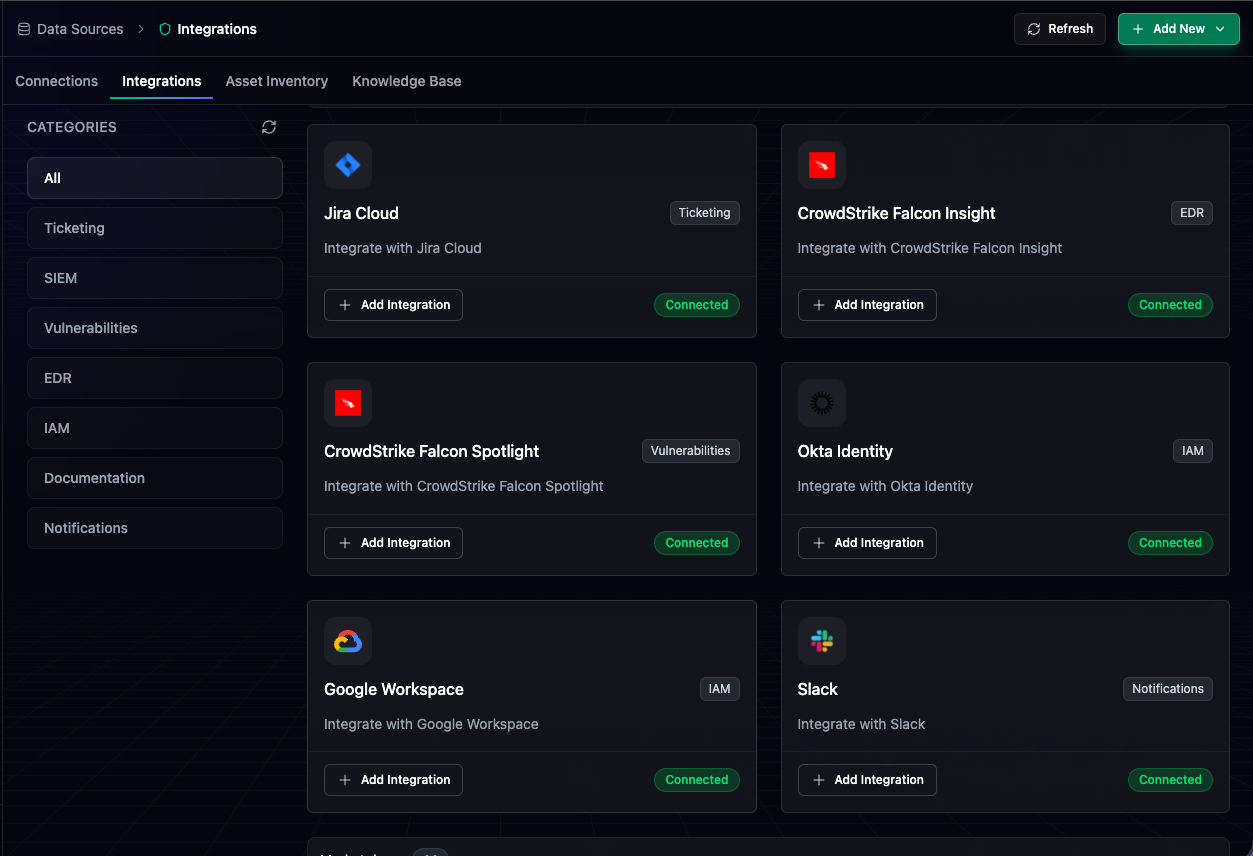RAD has been rebuilt from the inside out to make security work clear, fast, and verifiable. Every element—the layout, data model, and interaction flow—was redesigned around how real teams investigate and act.
The new interface expresses RAD’s core purpose: an Agentic AI Security Core that connects your stack, correlates signals with reasoning, and turns insight into accountable action. Our core product, RAD FusionAI, was designed to fulfill our core mission: to make security make sense.
Over a year of customer feedback shaped this release. Security leaders asked for context that stays intact, evidence that explains itself, and automation that earns trust. The new RAD Platform delivers all three.
A Redesign Rooted in Reality
This new version of RAD grew directly out of customer conversations. Engineers walked us through their daily patterns: the slack pings, the context pivots, the half-finished triage notes, the time lost hunting for proof. Leaders showed us the reporting burden that never let up.
We rebuilt RAD to meet those patterns head-on.
The investigation workspace now reflects how work actually unfolds. Signals from your stack (cloud, identity, runtime, scanners) arrive as they are, then merge into findings with clean lineage and clear ownership. Context sits beside the evidence it comes from, so the full picture forms quickly and stays stable as you act.
From that same surface, you can move work forward without losing your place. Tickets carry embedded evidence. Slack notifications include the same context the platform used to generate them. Fixes stay tied to the reasoning that suggested them. The entire workflow remains connected, from first signal to documented action.
The redesign began with a simple question: What slows teams down the most?
The new platform answers it with an experience that keeps attention pointed at the work—not at the tool.
Evidence That Holds Up
Trust depends on proof, and proof depends on context that survives each handoff. RAD now treats evidence as a first-class object—collected automatically, stored intact, and visible at every stage of an investigation.
Each signal enters the system with its full metadata: timestamp, source, and affected asset. The platform preserves that lineage as findings evolve, so the data that triggered an insight always remains connected to the reasoning behind it. You see exactly how RAD reached its conclusion, step by step.

The Evidence Room makes this transparent. It links detections across tools, maps them to users and controls, and presents a single thread from cause to outcome. Whether you’re reviewing a fix, preparing a compliance packet, or reporting to leadership, every fact and action share the same verified lineage.
Audit-ready is the natural byproduct of how RAD works now. The system documents itself as the team moves.
The Conversation Layer
When we first watched users work in their security tools across their stack to answer real questions, we saw the same scene play out again and again. Someone was mid-investigation, halfway through a Slack message, with three browser tabs open—each holding one missing piece of context. The question was simple…but the path to the answer wasn’t.
That pattern shaped the new RADBot. Now, instead of searching through dashboards, you ask directly: “What triggered this alert?” “Which user deployed this change?” “Where else does this role appear?”
RADBot pulls the right data, explains its reasoning, and links every answer back to the evidence that supports it.

The conversation itself becomes part of the investigation record. Questions, responses, and actions stay connected to the same underlying findings, forming a running thread of institutional knowledge. Over time, the log becomes a second memory for the team: alive, searchable, and always anchored in real data.
This layer changes how security feels. Instead of searching, you ask. Instead of switching tools, you stay in flow. The system meets you where the question starts and carries the reasoning through to the answer.
Connected End to End
Every part of the RAD Platform now works as one system. Signals arrive from detection tools, cloud accounts, and identity providers, then flow through a shared reasoning layer that keeps structure, metadata, and lineage intact.
RAD FusionAI is the center of that flow. It ingests alerts, configuration data, and activity logs from sources like Wiz, Okta, Qualys, and AWS, tagging each with precise origin details. FusionAI correlates those inputs, links them to affected assets, and enriches them with runtime context. Nothing is abstracted away; the raw signal remains available at every step.

Downstream, that fidelity becomes coordination. A finding identified in Wiz can generate a ticket in Jira, notify the responsible owner in Slack, and attach its evidence to a compliance control, all referencing the same underlying record. The chain of context never breaks, even as work moves across tools and teams.
This architecture turns the platform into connective tissue for security work. It keeps information whole, so every investigation, handoff, and report draws from a single, verified source of truth.
What’s Next
This release marks the foundation of the RAD Platform: a unified core where data, reasoning, and action stay connected. It redefines what the product is and how teams use it.
The next step builds on that foundation. In the second part of this series, we’ll introduce RAD’s AI Workers: autonomous components that act across your environment with the same discipline the platform now brings to investigation and evidence. Each Worker specializes in a domain: tracing blast radius, prioritizing vulnerabilities, preparing compliance reports. They execute within guardrails, record every step, and extend the same transparency already built into the core.
Together, the Platform and its Workers form an end-to-end system: intelligence that explains itself, automation that documents itself, and security that operates with evidence at every turn.
The future of RAD is here: both visible in how this new platform works, and in what comes next.





.png)


